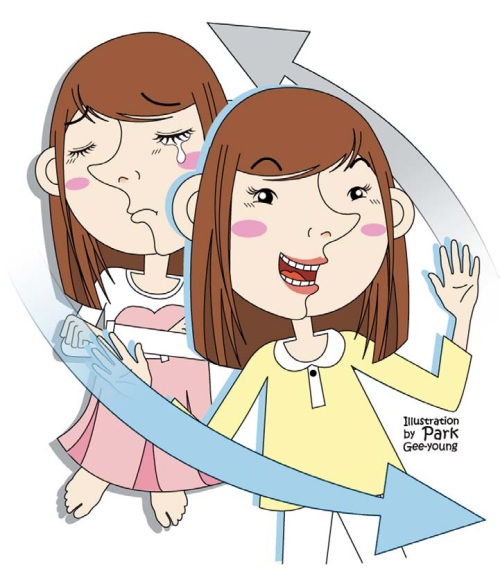Bipolar disorder gets its name because it is associated with mood swings from one extreme to the other. It used to be called manic depression, as it involves both the lows of depression and the highs of mania. People with this illness experience unusual shifts in emotional states that occur in distinct periods.
A manic episode includes a long period in a joyful, happy and energetic state. Patients become highly talkative, restless and overconfident. They have a decreased need for sleep, jump from one idea to another, their thoughts race, they make impulsive financial choices and show aggressive behavior. Severe mania can even bring hallucinations or delusions.
People with mild episodes may appear positive as they entertain others and show increased creativity.
However, as symptoms worsen, they often cause trouble by making poor judgment and engaging in reckless behavior and have relationship problems with those around them due to becoming explosive and irritable.

Episodes of mania shift back and forth with episodes of depression (the cycle may be as short as less than a year or as long as 10-20 years).
Before, after and between manic episodes, depressive episodes appear, with signs and symptoms including depression, less or no interest in carrying out everyday activities, loss of appetite, sleep deprivation or excessive sleep, hopelessness, sadness and a decline in energy. Mild depressive episodes may pass unrecognized, and some patients experience only manic episodes without alternating between mania and depression.
The lifetime prevalence rate of bipolar disorder is around 1 percent. It occurs across a wide range of ages from teens to those in their 50s, but it is most frequently diagnosed among those in their 20s. There are no significant gender distinctions.
Comorbidity with alcoholism, eating disorders, panic disorder, obsessive compulsive disorder, and ADHD is not infrequent.
The causes of bipolar disorder are yet to be fully discovered, but it is presumed to be caused by changes in the molecular structure of the central nervous system. Drug therapy is effective in stabilizing moods. There are three to four medications commonly prescribed based on symptoms and individual conditions.
Most patients develop normal mood patterns once medications are administered. However, it is a cyclical illness and is highly likely to recur. Thus, it is important for patients to keep taking medications for the advised periods and regularly visit the physician to check current conditions and prevent recurrence.
It may recur during the treatment. If early symptoms such as insomnia or mood changes occur, readjustment of medication and more intensive and frequent clinical interviews are necessary to prevent further aggravation. For recovery and prevention of disease recurrence, maintenance of medication and stress-management are important.
Too high set up the goal in hard work or yourself is not desirable. Patients need to keep regular sleep-wake cycle and meal time. Waking up during night and sleeping at daytime is very harmful, and shift-work should be avoided. Taking 30 minute though one hour light therapy (using light box), especially for wintertime, is known to be helpful to improve depressive symptoms. Usual walk, exercise, hobbies and stable interpersonal relationships are also helpful.

By Hong Kyung-sue
The author is a doctor at Department of Psychiatry of Samsung Medical Center and professor of professor of Sungkyunkwan University School of Medicine – Ed.
A manic episode includes a long period in a joyful, happy and energetic state. Patients become highly talkative, restless and overconfident. They have a decreased need for sleep, jump from one idea to another, their thoughts race, they make impulsive financial choices and show aggressive behavior. Severe mania can even bring hallucinations or delusions.
People with mild episodes may appear positive as they entertain others and show increased creativity.
However, as symptoms worsen, they often cause trouble by making poor judgment and engaging in reckless behavior and have relationship problems with those around them due to becoming explosive and irritable.

Episodes of mania shift back and forth with episodes of depression (the cycle may be as short as less than a year or as long as 10-20 years).
Before, after and between manic episodes, depressive episodes appear, with signs and symptoms including depression, less or no interest in carrying out everyday activities, loss of appetite, sleep deprivation or excessive sleep, hopelessness, sadness and a decline in energy. Mild depressive episodes may pass unrecognized, and some patients experience only manic episodes without alternating between mania and depression.
The lifetime prevalence rate of bipolar disorder is around 1 percent. It occurs across a wide range of ages from teens to those in their 50s, but it is most frequently diagnosed among those in their 20s. There are no significant gender distinctions.
Comorbidity with alcoholism, eating disorders, panic disorder, obsessive compulsive disorder, and ADHD is not infrequent.
The causes of bipolar disorder are yet to be fully discovered, but it is presumed to be caused by changes in the molecular structure of the central nervous system. Drug therapy is effective in stabilizing moods. There are three to four medications commonly prescribed based on symptoms and individual conditions.
Most patients develop normal mood patterns once medications are administered. However, it is a cyclical illness and is highly likely to recur. Thus, it is important for patients to keep taking medications for the advised periods and regularly visit the physician to check current conditions and prevent recurrence.
It may recur during the treatment. If early symptoms such as insomnia or mood changes occur, readjustment of medication and more intensive and frequent clinical interviews are necessary to prevent further aggravation. For recovery and prevention of disease recurrence, maintenance of medication and stress-management are important.
Too high set up the goal in hard work or yourself is not desirable. Patients need to keep regular sleep-wake cycle and meal time. Waking up during night and sleeping at daytime is very harmful, and shift-work should be avoided. Taking 30 minute though one hour light therapy (using light box), especially for wintertime, is known to be helpful to improve depressive symptoms. Usual walk, exercise, hobbies and stable interpersonal relationships are also helpful.

By Hong Kyung-sue
The author is a doctor at Department of Psychiatry of Samsung Medical Center and professor of professor of Sungkyunkwan University School of Medicine – Ed.
-
Articles by Korea Herald


![[AtoZ into Korean mind] Humor in Korea: Navigating the line between what's funny and not](http://res.heraldm.com/phpwas/restmb_idxmake.php?idx=644&simg=/content/image/2024/04/22/20240422050642_0.jpg&u=)


![[Exclusive] Korean military set to ban iPhones over 'security' concerns](http://res.heraldm.com/phpwas/restmb_idxmake.php?idx=644&simg=/content/image/2024/04/23/20240423050599_0.jpg&u=20240423183955)
![[Herald Interview] Why Toss invited hackers to penetrate its system](http://res.heraldm.com/phpwas/restmb_idxmake.php?idx=644&simg=/content/image/2024/04/22/20240422050569_0.jpg&u=20240422150649)
![[Graphic News] 77% of young Koreans still financially dependent](http://res.heraldm.com/phpwas/restmb_idxmake.php?idx=644&simg=/content/image/2024/04/22/20240422050762_0.gif&u=)







![[Exclusive] Korean military to ban iPhones over security issues](http://res.heraldm.com/phpwas/restmb_idxmake.php?idx=652&simg=/content/image/2024/04/23/20240423050599_0.jpg&u=20240423183955)



![[Today’s K-pop] Ateez confirms US tour details](http://res.heraldm.com/phpwas/restmb_idxmake.php?idx=642&simg=/content/image/2024/04/23/20240423050700_0.jpg&u=)